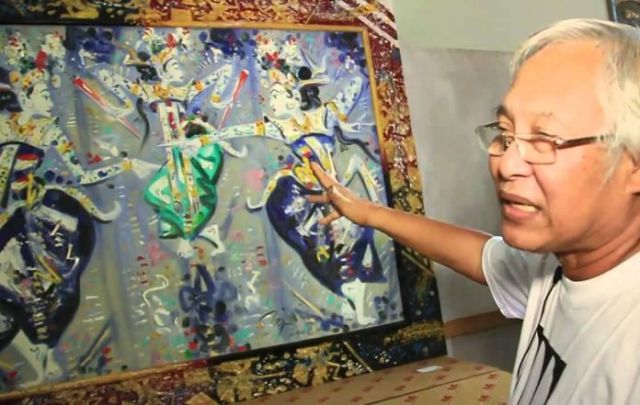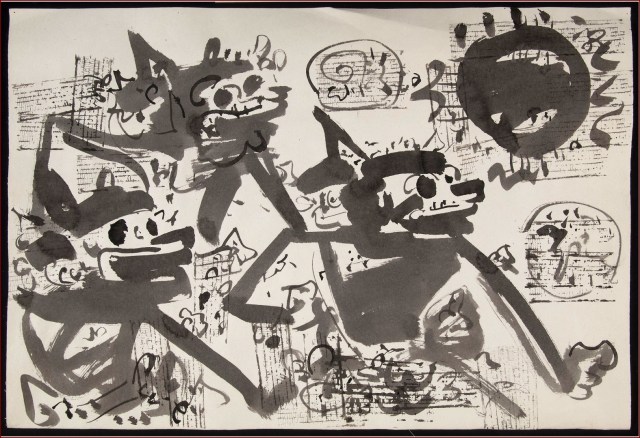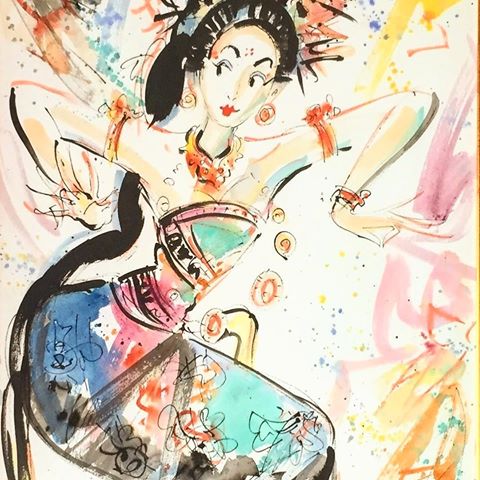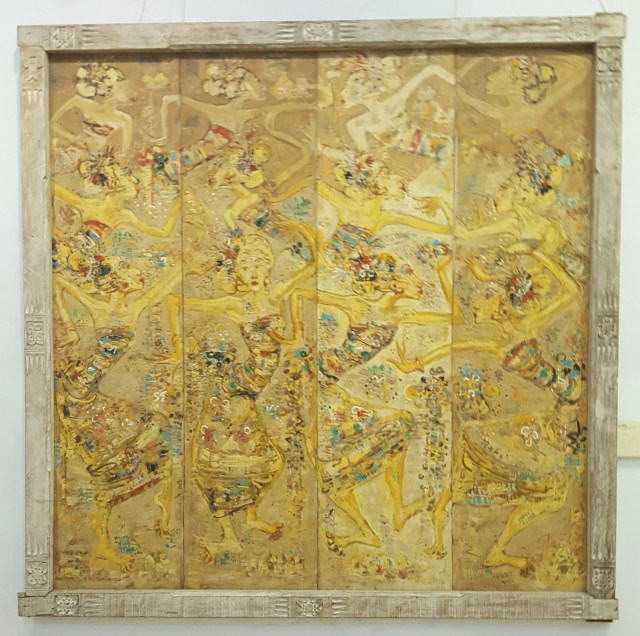 RIP Nyoman Gunarsa – One of Bali’s pioneering modern artist
RIP Nyoman Gunarsa – One of Bali’s pioneering modern artist
With the recent passing of Balinese artist Nyoman Gunarsa on the 10th September 2017 an important chapter of Balinese art comes to a close. His legacy as an artist, art lecturer, art collective leader and museum owner, however, will be long lasting. Born in Klungkung, East Bali in 1944, Gunarsa was the first post war Balinese artist to rise to national prominence. His contribution to the development of Balinese art as one of the pioneering modern expressionist painters was in the exploration of form, rather than the narrative.
Gunarsa’s energetic style of applying paint to canvas with spontaneous, gestural brushstrokes was likened by some to a musical conductor, and he was affectionately known as the maestro. Raised nearby to the village of Kamasan, which during the 16th – 20th centuries was the epicenter of Balinese Classical art, Gunarsa was renowned for his dedication to the art of his forefathers. Academically trained, he quickly matured as a realism painter, yet in the 1980’s his fresh approach to depicting the characters from the Wayang Kulit shadow puppet theater broke new aesthetic grounds in Balinese art.
 Gunarsa’s dynamic paintings emphasized the energy and movement that typified Balinese performance and ceremony.
Gunarsa’s dynamic paintings emphasized the energy and movement that typified Balinese performance and ceremony.
The foundation of Balinese art is drawing. The strictly governed rules and techniques that characterize the Classical style begin with the sketching of the composition, the drawing of the fine black ink outlines of all visual information, and the coloring in of figures, forms and motifs. Originally these were collective works completed by a group of artists, as a communal offering of gratitude to the Gods. The application of color involved controlled brushstrokes, layered until the desired results are achieved – a brushwork technique akin to drawing, or penciling in the colorful hues.
Gunarsa’s signature style was an adaptation from western art, in which the individual’s innovative ideas, emotions and energy are omnipotent. Freedom and power of expressive, often minimal brushstrokes defined his visual approach. Gunarsa captured a fresh sense of dynamism in his interpretations of iconic scenarios from the Balinese Hindu legends, along with his revolutionary method of capturing traditional ceremony and performance, especially beautiful women dancing. Fusing his cultural knowledge with elements of expressionism and abstract painting immediately set his work apart from that of his contemporaries.

Colorful, pulsating movement and vitality categorize Balinese ceremony, performance and dance. This has been a source of inspiration for artists over many generations, yet never had a painter captured the seen, and unseen elements of energy, with Gunarsa’s colorful vibrancy. Form along with the decorative elements of Balinese Classical painting took on wonderful new life, and an exciting, newfound match for the unique, real visual spectacle was born.
As an art lecturer at Yogyakarta’s ASRI (Academi Seni Rupa Indonesia) during the late 1960’s and into the 1970’s Gunarsa was a catalyst to great change. He shared his vast knowledge and enthusiasm with a new, young generation of Balinese artists, the first to venture outside of their cultural structures and restraints, to be academically trained in Central Java. These were the formative days of Balinese contemporary art. Via their fresh approach to exploration and expression using new and unusual media they transformed Balinese philosophies, rituals and symbols into an exciting new visual language.

Gunarsa helped establish Indonesia’s longest running artist collective, Sanggar Dewata Indonesia, SDI (Workshop of the Gods) in 1970, inviting his Balinese students to form the new association. SDI grew to create a social collective to coordinate artistic activities, exhibitions and organize debates on art outside the institutional teaching framework. It offered its members freedom to collaborate and create without having to fear being labeled as supporters of certain political parties, during a highly politicized era of Indonesian history.
While the influential 1936 – 1945 Pita Maha artists collective redefined Balinese traditional art with modern aesthetics for the burgeoning tourist market, SDI set about redefining from the artist’s perspective based on the search for new ideas, self-expression, and national identity. This new art movement laid the foundations for the future, while inspiring many young artist to study in Yogyakarta, and Balinese contemporary art evolved to reveal its own distinct ‘voice’ in world art, while spawning generations of talented artists.

During the 1980’s – 1990’s Gunarsa and others such as Wianta, Sika, Djirna and Erawan enjoyed national and international success. Gunarsa opened the Museum of Contemporary Indonesian Painting in Yogyakarta in 1989. His next milestone was in 1994 when the Nyoman Gunarsa Museum of Classical Painting opened next to his residence in Klungkung. In the 3-storey venue he combined his own works with Classical paintings from the 17th – 19th centuries. Dedicated to the preservation of this unique art form Gunarsa acquired scarce works, including ones painted on rare ulantaga bark paper.
Artifacts, stone and woodcarvings, traditional furniture, masks, sculptures and a collection of sacred ceremonial kris add to the historical significance of his museum. In August 2017 the Indonesian President Joko Widodo attended an official reception at the museum in Gunarsa’s honor. As an international, multi award winning artist Gunarsa held solo exhibitions in more than ten foreign countries.

A landmark celebration of Balinese art was held from July – October 2012 at Gunarsa’s museum, The First International Festival of Classical Balinese Painting. The festival included works from collections of seven other countries, along with the participation of some of the world’s leading foreign authorities on Balinese Classical art. “Classical Balinese paintings have been admired world wide since the European society first became acquainted with the East in the 15th century,” said Gunarsa. “And since then other countries have searched out these masterpieces to enrich their cultural references because of the extraordinary implied messages, philosophies, and counsels about the life of the Balinese.”

Words & Images: Richard Horstman
*Author’s note: No part of the written content of this website may be copied or reproduced in any form, along with article links uploaded to other websites, for any commercial purposes without the written permission of the author. Copyright 2024